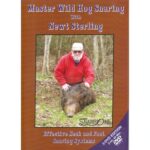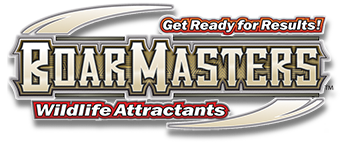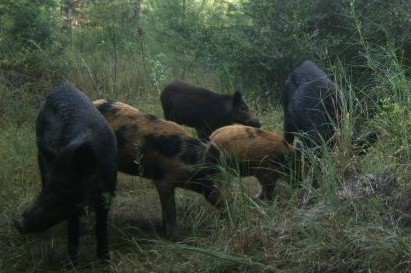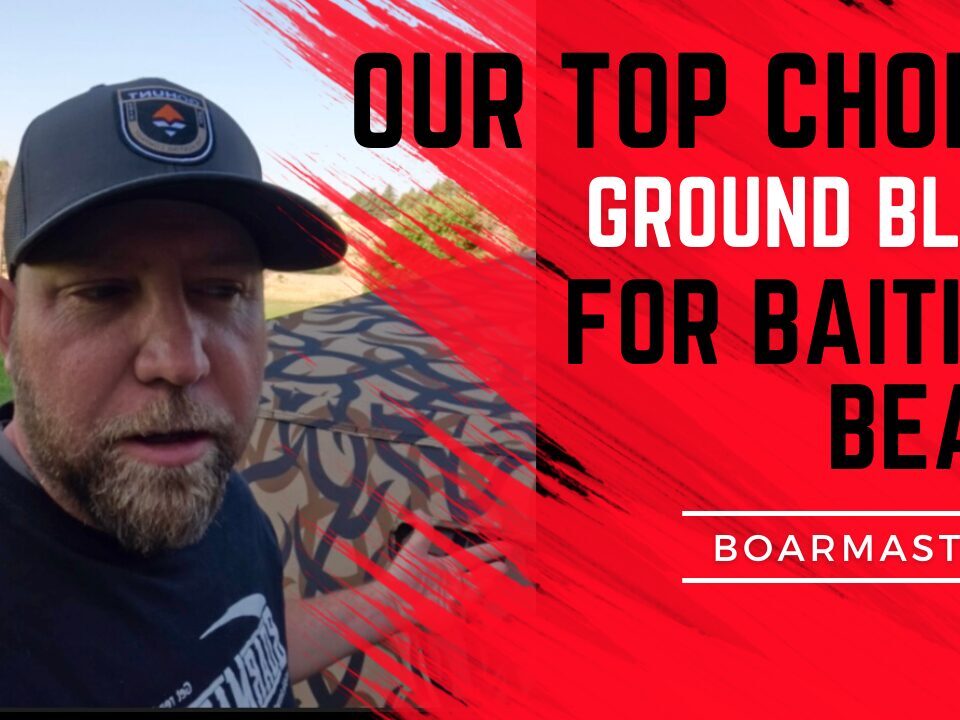
Mastering Wild Hog snaring with Newt Sterling
November 4, 2015
Love for the working dog by Mike Pimentel
March 25, 2016BOARMASTERS MANUFACTURES THE PERFECT HOG SNARE. CLICK HERE
Great Article from the Agrilife Extension Texas A&M System
Snaring Feral Hogs
Chancey Lewis, Matt Berg, Nikki Dictson, Jim Gallagher, Mark McFarland, and James C. Cathey*
Feral hog populations across Texas are damaging water quality, wildlife habitat, home landscapes, and agricultural production. To manage these animals effectively, landowners and managers must deploy a diverse set of approaches. In situations where capturing a small number of animals inexpensively and with little maintenance is desirable, snares can be a key component of a larger control strategy. Advantages • Snaring is relatively inexpensive and does not require pre-baiting. • Snares catch trap-shy hogs effectively. • Snares can be used in a variety of situations. • They can be set quickly and easily and require very little maintenance. Disadvantages • Snaring captures only one hog at a time. • This method is inappropriate where the risk of capturing nontarget species is high. • Snaring is inappropriate where anchor points are lacking. • Large hogs occasionally break snares. Snare design A snare consists of a loop of steel cable attached to a secure object and placed so that the loop catches the animal as it passes through a confined space. Use a 1⁄8-inch galvanized steel
cable to prepare a snare for feral hogs. The snare should have a sliding lock device allowing the loop to close but not open easily. To minimize the problems of a captured animal breaking the cable, use a heavy swivel on the end of the cable that is attached to an anchored structure (fence post, tree, utility pole; Fig. 1). In most situations, install a deer stop device to prevent the snare from closing entirely. Crimp a single ferrule, small nut, or other similar hardware to the snare cable to ensure that the snare does not close around the leg of a deer or other nontarget animal. The stop should prevent the snare from closing all the way. Preparation To make snares easier to conceal, use one of the following approaches: • Boil new snares and extension cables in water
SNARING FERAL HOGS | 1
*Former Extension Assistant; Extension Program Specialist; Extension Program Specialist II; Assistant Extension Wildlife Specialist; Professor and Extension Soil Fertility Specialist; and Associate Professor and Extension Wildlife Specialist All of The Texas A&M University System
L-5528 02-11
Snaring Feral Hogs Chancey Lewis, Matt Berg, Nikki Dictson, Jim Gallagher, Mark McFarland, and James C. Cathey*
A complete 1⁄8-inch cable snare with a lock and end swivel for capturing feral hogs.
Figure 1
2 | SNARING FERAL HOGS
with detergent and hang them outdoors for a few months until they turn a dull gray. • Boil the snares in 4 tablespoons of baking soda for 1 hour to age their appearance. • Dye the snares a dark color by boiling them in brown logwood crystals and dye. Commercial dyes for snares are available from trap supply dealers. After boiling snares, keep them free of odors. Store them in a container with cedar boughs, broomweed, or other natural smells. To avoid scent contamination, wear clean gloves when handling and setting snares. When considering sites for snares, look for animal travel ways (trails) or crossings under fences around crop fields or pastures (Fig. 2).
Fence snare sets Snares for capturing feral hogs are commonly placed under fences where hogs are known to cross. These “crawls” can be identified by tracks on the trail or hair caught on the fence. Hogs often push under a fence and bend the bottom wires up into a visible arc. A game camera can also help determine feral hog behavior in the area and identify the optimal sites for snare placement. Snared feral hogs, particularly large animals, can damage a fence. Do not tie the snare directly to the fence wire. Instead, secure it to a large drag or fixed anchor point. To minimize fence damage, check the snares daily. The swivel end of a snare is most often tied
Locations (A and B) where hogs cross under fences provide good places to set snares. Look for evidence of hog activity, such as tracks and hair, to reduce the likelihood of capturing nontarget species.
Installation of a fence snare set (A). Once in place, the snare becomes difficult to see, as it blends into the fence or background (B).
SNARING FERAL HOGS | 3
with a doubled or tripled length of tie wire to a secure anchor point or drag (Fig. 3). Suspend the snare’s loop from the bottom of the fence with U-shaped wire clips or a single wrap of small gauge copper wire so that the loop pulls free easily when the animal passes through it. To protect a weak fence or prevent landscape damage by captured hogs, use a cable extension to attach the snare to a large log, uprooted stump, or similar weighted object, which then serves as a drag. Trail, tree, and post sets In areas where there is little risk of capturing sheep, goats, calves, deer, or other nontarget animals, snares can be set in trails used by hogs. Snares can also be set directly onto rubs that the hogs are using. Hogs rub against objects to scratch and remove parasites. Rubs may be found on utility poles, bridge pilings, or on trees surrounding wallowing areas (Fig. 4). One advantage to setting snares on rubs is that you are much less likely to catch nontarget species. Also, you can set multiple snares in
known wallowing areas where rubs are common, increasing the potential for capture. A flexible yet durable piece of wire (clothing hanger or baling wire) can be used to hang the snare (Fig. 5A). Bend an inverted S-shape in the wire to give support to the snare. The tail end of the wire can be angled down into the tree or post for extra support. This method also ensures that the support wire does not slip. When setting the snare, be sure to place the lock at either the 11 o’clock or 1 o’clock position to ensure that the snare triggers properly when a hog enters the loop (Fig. 5B).
A feral hog trail crosses under a fence near a utility pole (A). This rub makes an ideal location to set a snare. Rubs can also be found on trees near foraging areas (B).
Figure 4
Closeup of snare brace hanger (A). A brace made from a clothing hanger or other heavy wire can be used to set a snare at a rub location or a known feral hog trail (B). Feral hogs will return to this utility pole for rubbing (C). A wire brace was used to extend the snare into position.
Figure 5
4 | SNARING FERAL HOGS
To catch a 30-pound hog, make a loop of 10 to 12 inches and suspend it 7 to 8 inches off the ground. Increase the loop size and height to catch larger hogs (Fig. 5C); a loop size of 20 inches or more may be appropriate. If the snare is not long enough, use cable extensions to attach it to a tree, drag, pole, or steel stakes driven into the ground. Avoid capturing nontarget animals • Avoid setting snares on trails used by livestock and other nontarget animals. • Do not set snares under fences where deer or dogs are known to pass. • Keep detailed records on the locations and number of snares so that all can be found. • Remove snares when they cannot be checked often. State regulations The Texas Parks and Wildlife Department (TPWD) regulates hunting in Texas, and a hunting license is required to take feral hogs for meat consumption or trophy. However, this requirement is waived if the landowner or lessee (if given landowner permission) takes feral hogs causing damage or depredation on the property. Snares are not species specific, and they are likely to capture other animals. Consequently, it
is recommended that you buy a hunting license, which is required for snaring animals such as bobcats, raccoons, and opossums. When snaring feral hogs in Texas, you are not required to have deer stops, but it is a good idea to do so. A deer stop is a device that prevents the snare from closing past a certain point, allowing a captured deer to pull its leg out of the snare. Because it is illegal to snare deer, take proper precautions to avoid doing so. If you use snares to capture feral hogs, follow the hunting laws outlined in the TPWD Outdoor Annual and contact the local TPWD game warden for more details on the use of snares for feral hog control. Summary Snares can be an important part of a feral hog management strategy. Although they can capture only one animal at a time and risk taking nontarget species, they can be an inexpensive, low-maintenance approach applicable to many different situations.
Acknowledgment and disclaimer This publication was developed as part of the Plum Creek Watershed Feral Hog Project, with funding support from the U.S. Environmental Protection Agency through a Clean Water Act §319(h) Nonpoint Source grant administered by the Texas State Soil and Water Conservation Board and from the Cooperative State Research, Education, and Extension Service, U.S. Department of Agriculture (USDA), National Integrated Water Quality Program. Any opinions, findings, conclusions, or recommendations expressed in this publication are those of the author(s) and do not necessarily reflect the view of the USDA.
Educational programs of the Texas AgriLife Extension Service are open to all people without regard to race, color, sex, disability, religion, age or national origin. _____________________________________________________________________________________________________________________________________________ Issued in furtherance of Cooperative Extension Work in Agriculture and Home Economics, Acts of Congress of May 8, 1914, as amended, and June 30, 1914, in cooperation with the United States Department of Agriculture. Edward G. Smith, Director, Texas AgriLife Extension Service, The Texas A&M University


